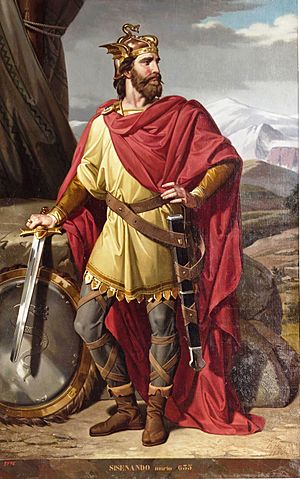Sisenand facts for kids
Sisenand (born around 605) was a Visigothic king who ruled parts of what are now Spain, Portugal, and southern France. He became king in 631 and ruled for about five years until his death in 636. His time as king was important for setting new laws and rules for the Visigothic kingdom.
Contents
Sisenand's Time as King
How Sisenand Became King
Sisenand was a governor in a region called Septimania. At that time, the Visigothic king, Suintila, was not very popular. Many nobles were unhappy because King Suintila had taken their lands and given special favors to others. Sisenand joined these unhappy nobles in a rebellion against Suintila.
To help their cause, Sisenand and the nobles asked Dagobert I, the King of the Franks, for help. The Frankish king agreed to assist them. In return, the Gothic nobles promised Dagobert a very special gift: a large plate made of pure gold, weighing 500 pounds! This golden plate was said to be a gift from a Roman general named Aetius to an earlier Visigothic king in 451.
Sisenand and his allies successfully overthrew King Suintila. They captured the city of Zaragoza on March 26, 631. After this victory, Sisenand declared himself the new king. His rise to power showed that the nobles had become very strong in the kingdom. The church leaders also gained more influence during this time.
Early Actions as King
Once Sisenand became king, he made sure that the previous king, Suintila, was officially called a "tyrant." This meant Suintila was blamed for many wrongs, like taking wealth from poor people. Sisenand also removed all taxes that the church leaders had to pay. This made the clergy very happy and supportive of his rule.
A Small Uprising
Between 632 and 633, there was a small attempt to rebel against Sisenand. A person named Iudila tried to become king. We know about this because two coins were found from the cities of Mérida and Granada with "IUDILA REX" (Iudila King) written on them. However, this rebellion did not succeed, and Iudila was later defeated.
The Fourth Council of Toledo
To make sure everyone, especially the church, supported his rule, Sisenand called for a very important meeting. This meeting was called the Fourth Council of Toledo, and it happened on December 8, 633.
At this council, leaders created new laws for both the government and the church within the Visigothic kingdom. These laws included serious punishments for anyone who rebelled against the king. However, the council also decided that the king's position would not be passed down from father to son. Instead, the next king would be chosen by the bishops and important nobles from among themselves.
The End of Sisenand's Reign
King Sisenand died peacefully in the city of Toledo on March 12, 636. After his death, the bishops chose Chintila to be the next king of the Visigoths.
See also
 In Spanish: Sisenando para niños
In Spanish: Sisenando para niños


